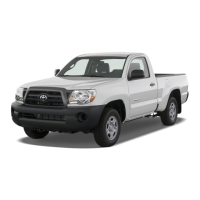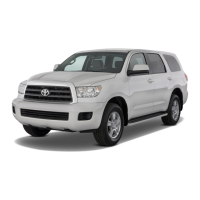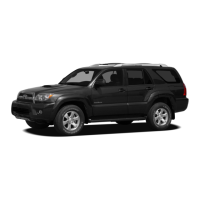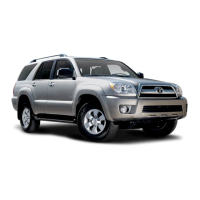241
2008 TUNDRA from Apr. ’08 Prod. (OM34477U)
The “4LO” (low speed four−wheel drive)
indicator light comes on when the “4L”
mode is selected.
Use this for maximum power and traction.
Use “4L” position for climbing or descend-
ing steep hills, off−road driving, and hard
pulling in sand, mud or deep snow.
See “(c) Shifting procedure” for further in-
structions.
In this mode, the vehicle stability control
system is off. (See “Vehicle stability
control system” on page 250 in this
Section.)
The A.D.D. can be engaged or disen-
gaged by the shifting operations de-
scribed in “(c) Shifting procedure”.
You should drive in four−wheel drive for
at least 16 km (10 miles) each month.
This will assure that the front drive com-
ponents are lubricated.
SHIFTING BETWEEN “2WD” AND “4H”
To shift from “2WD” to “4H”, reduce the
vehicle speed to less than 100 km/h (62
mph) and turn the front drive control
switch knob fully clockwise.
When the ambient temperature is −15#C
(5.0#F) or lower, shifting must be per-
formed with the vehicle speed below 70
km/h (43 mph).
If the “4HI” (high speed four−wheel drive)
indicator light continues to blink when you
operate the front drive control switch knob
from the “2WD” to the “4H” position, this
reminds you that the transfer mode is not
securely in “4H” mode. Drive straight
ahead while accelerating or decelerating.
If the “4HI” (high speed four−wheel drive)
indicator light continues to blink and the
buzzer sounds when you operate the front
drive control switch knob from the “2WD”
to the “4H” position, this reminds you that
the transfer mode is not in “4H” mode.
Stop the vehicle or reduce the vehicle
speed to less than 100 km/h (62 mph).
(When the ambient temperature is −15#C
(5.0#F) or lower, speed needs to be re-
duced to below 70 km/h (43 mph).) Oper-
ate the switch knob again.
07 11.20
(b) A.D.D. (automatic
disconnecting differential)
(c) Shifting procedure
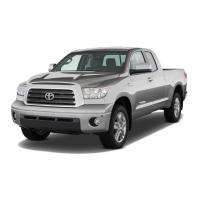
